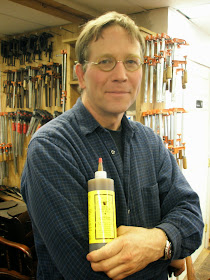 |
| Old Brown Glue Hard at Work |
At some point, Brian discovered the liquid animal glue I was using every day, and told me he wanted to try it for his chairs. He found out it worked great and insisted that I start putting it into a bottle so I could sell it. Thanks to Brian, I decided to begin selling glue and came up with the basic name, Old Brown Glue. I reasoned that woodworkers were used to calling their synthetic glue either yellow or white, so I went with brown.
I remember when I was asked by Joel at Tools For Working Wood to supply him with the liquid hide glue as a commercial distributor. Before that, simple word of mouth about the glue meant that we would get a phone call from time to time asking if we could sell a bottle. I guess we were selling about 3 or 4 bottles a week, on average. Joel suggested that we make two sizes available, a 20 oz (net weight) and a 5 ounce. I resisted putting the glue in smaller bottles, since I used it all the time and the larger bottles were fine.
In any event, for several years, Tools For Working Wood was the only place where you could buy the glue, outside of direct sales from my business.
Then the internet took over, and people who used it wrote nice things about it. Cabinet makers, chair makers, luthiers, and even museum conservators all commented positively and the phone calls increased dramatically.
The next phase was when Lee Valley called and placed a large order, forcing us to design labels in both French and English, as well as convincing the Canadian government that our glue was not toxic or dangerous. As soon as we finished with the paperwork, our glue was placed in stores across Canada.
Soon after, Rockler contacted us and began stocking our glue in their stores. Between Rockler and Lee Valley, I was cooking glue every week, filling bottles and shipping out large boxes of product.
That meant I needed a cooking space in the business, as well as a bottling place, a labeling place, and a shipping department. At that point, there was a fairly continuous flow of glue from one end of the business to the other.
We joked about contacting Home Depot and visualized seeing our product sitting on the end isles next to the infamous Gorilla. Yeah, right...
However, last month we were contacted by Woodcraft Supply, and they placed a very large order! In fact, they followed up that order with two more, even larger. Now I am cooking glue every day, going through 50 pound bags of Milligan and Higgins glue as fast as I can open them. We are needing to order bottles and labels all the time, and the glue is everywhere.
The other day, I searched on Google for "Old Brown Glue" and found the first ad for this was on Amazon! Woodcraft is selling our glue on Amazon!! Check it out.
Move over Gorilla, who needs Home Depot?
 |
| Got Glue? |






